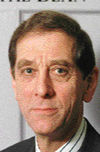Samuel Gompers, a founder and first president of the American Federation of Labor, succinctly summarized its aims as "More!" It is unlikely that FAS dean Jeremy R. Knowles  had that antecedent in mind in January when he put forth as a guide to managing Harvard's largest academic unit "a single goal for the coming years: we must increase the number of professors in the Faculty of Arts and Sciences...." But the substance and simplicity of his proposed objective certainly resonate in a way Gompers might have admired.
had that antecedent in mind in January when he put forth as a guide to managing Harvard's largest academic unit "a single goal for the coming years: we must increase the number of professors in the Faculty of Arts and Sciences...." But the substance and simplicity of his proposed objective certainly resonate in a way Gompers might have admired.
The occasion was Knowles's annual letter to FAS members. He began by reflecting on a decade that "began with daunting deficits" and ended with much more favorable conditions brought about by "financial discipline" and by "low inflation, by the superb performance of the endowment in robust financial markets, and by the good fortune of mounting a capital campaign in these somewhat heady times." As a result, the dean observed, the faculty can consider options for "a more secure future," looking beyond routine "housekeeping projects of maintenance and improvement."
Doing so, the dean then asked, "How should we invest our new resources to transform the educational experience of our undergraduates and graduate students, and to improve the scholarly lives of the faculty?" His answer: aim to increase the FAS ranks by six new members annually during the next decade--a total of 60 additional positions--"while keeping the size of the College constant and the size of the Graduate School steady."
If achieved, that would represent both substantial growth--10 percent more professors--and a reversal from the experience of the recent past. FAS's tenured and junior-faculty ranks have numbered approximately 600 since 1989, and although the University Campaign yielded 28 new endowed professorships in FAS, the goal was 40.
Sustained growth in the number of faculty members would yield benefits across the board, Knowles maintains. "For our undergraduates," he wrote, "I believe we should consider the desirability of offering a seminar experience for every freshman, of more effective advising, of more research opportunities, and of further reductions in sec-
tion size." Graduate students might gain access to "research apprenticeships," allowing them to form a network of faculty relationships before settling on a scholarly approach and a dissertation adviser. Finally, an expanded professoriate promises FAS members themselves more time--for advising, research, and scholarly leaves--even with smaller class sizes.
In recent years, new faculty positions have been allocated to departments where rising enrollments have put excessive pressure on teaching. The new positions Knowles now proposes are not designated for particular departments, and in fact could give FAS more freedom to explore new areas of intellectual inquiry. For example, in commenting on FAS's science initiatives, Knowles noted that an emerging focus on digital science and technology "cannot move forward strongly without more faculty in computer science and electrical engineering." In this instance, widening the faculty's intellectual reach would also help meet soaring student demand for course offerings (see "Why Not .com?" page 84).
Focusing on faculty growth is not a self-contained program. Knowles addresses intersecting issues of retirement, recruitment, and efforts to retain junior faculty members (see page 75). And of pressing importance in Cambridge, a larger faculty brings physical planning to the fore. "Already, space issues threaten to limit new appointments," Knowles observes, constraining growth in social sciences--where laboratories are now often as important as office space--and in many of the sciences and applied sciences. Beyond new life-sciences and physical-sciences buildings, and a planned addition to the Science Center, he suggests the need to examine options for the humanities along pinity Avenue; to relieve crowding in William James Hall, home to many social-sciences departments; and to consider, on behalf of the natural sciences, the best use of the large museum complex and the areas around the cyclotron, at the northern edge of campus (see "Good Zoning Makes Good Neighbors," November-December 1999, page 84).
Thus, seen through the simple lens of faculty numbers, FAS faces an agenda, "in these less financially constrained times," to support "existing but currently unfunded aspirations, and to embark upon a host of exciting new ventures." Gompers, who amplified "More!" on other occasions (to mean "more schoolhouses and less jails; more books and less arsenals; more learning and less vice; more leisure and less greed; more justice and less revenge; in fact, more of the opportunities to cultivate our better natures"), would surely understand.





